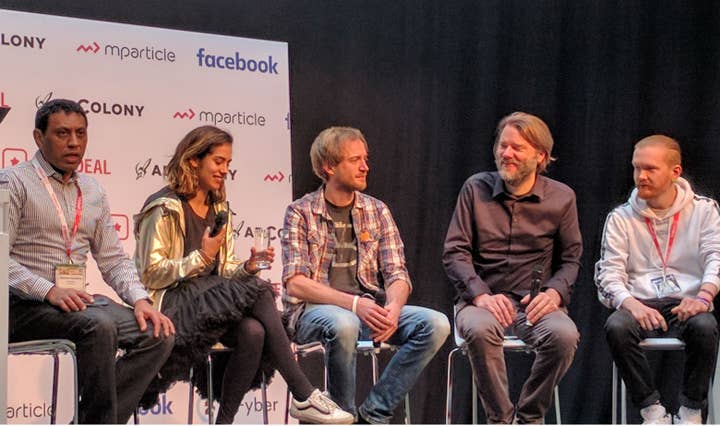Does VR need a Killer App?
At Casual Connect today, Valve's Chet Faliszek argued that, like the App Store, VR will succeed on flexibility rather than franchises
For many, the success of Resident Evil 7 and its atmospheric campaign has offered a glimpse of what a "killer app" for virtual reality might look like; the game that shifts the common perception of VR from an intriguing glimpse of the future, to an essential part of contemporary entertainment. The term will be familiar to anyone who has seen the launch of a new console, but, as a panel of experts discussed today at Casual Connect Europe, VR defies such easy categorisation.
The discussion was triggered by nDreams CEO Patrick O'Luanaigh, who was in the crowd to watch a panel that included representatives from Valve and Nvidia. When asked to pin down his definition of the term "Killer App," O'Luanaigh said, "it's less about revenue, more something that everybody talks about. A lot of people say that VR hasn't had that killer game yet.
"If we look to the consoles we might say, 'You have to have your Mario or your Sonic.' But do you?"
"There's lots of cool stuff out there, but nothing that really makes you feel, 'Oh my god, this is so amazing, I have to go and buy a headset.' We're all saying that we want games like that to come, and as budgets go up hopefully that will happen. It's really about where that game might come from."
For Chet Faliszek, who has become the globe-trotting representative for Valve's VR efforts, the very notion of a 'Killer App' seemed to belong more to traditional game hardware - the consoles made by Nintendo, Sega, Sony and Microsoft. "We have so few data points to extrapolate from to figure out what this is," he said. "If we look to the consoles we might say, 'You have to have your Mario, or your Sonic.' But do you?"
Faliszek referred to a talk he gave the previous day, in which he suggested smartphones as a more appropriate comparison for VR technology. "What was the killer app for the App Store?" he asked the crowd the previous day. "I would argue it was flexibility; the ability to become different for each person. If you'd have asked me 20 years ago what feature do I most want on my phone, I probably would say something about making phone calls; now I rarely make a phone call.
"That's where we are in VR right now - 20 years ago, just the start."

Faliszek emphasised this point again, and suggested that some of the difficulty analysts have faced in grappling with the VR market relates to this kind of misunderstanding. "That's why there's slower growth in virtual reality than other people predicted - the analysts," he continued. "Whereas I think people in the [VR] industry have the understanding that, if you demo ten individual things, out of those one person would say, 'Why is this thing in there?' And the next person would go, 'That's the best thing ever.'
"Today's high-end becomes tomorrow's mainstream... If you develop for the high-end, you know that's going to have the longest tail"
"You have these personal reactions... Everybody finds that thing in there that they want to have."
It was telling that, when asked about the most impressive applications for virtual reality right now, Faliszek listed tools for creativity: Google's Tilt Brush, and the VR development capabilities offered by engines from Unity and Epic. There is a desire for a fully formed consumer market for VR to hurry up and arrive already, but the truth may be that, even a year after the launch of Oculus Rift and HTC Vive, the space is still best defined by its creators and the broad range of use cases they are attempting to discover.
However, one basic truth was mentioned on several occasions, starting with O'Luanaigh's original question about the importance of positional head-tracking and motion controls becoming standard in mobile VR. These are core features the current high-end of VR hardware - including, but not limited to, the HTC Vive - but Faliszek also believes this is the smartest target for any developer wanting to reach the largest possible audience.
"If you want to make the most money in VR, you should make [games] for the largest addressable market," he said. "The largest addressable market right now may be headsets that are rotational only, but they will be museum piece in a couple of years. If you make something that has positionally tracked head and motion controls you can probably still be selling that game years from now - or some version of that. If you did rotational only? Someone has to pull a headset out of the closet to experience that. The shelf life of that product is going to be much shorter."
Faliszek made a similar point the day before, advising Casual Connect's attendees that, "today's high-end becomes tomorrow's mainstream. If you really want to think about the largest addressable market, it's not about the number of headsets out there for any one platform. It's what will become the standard. If you develop for the high-end, you know that's going to have the longest tail."
Despite the probable advantage in the number of headset owners, then, mobile VR may have to reach a better technological standard to be a better commercial opportunity. No part of the VR market offers a huge installed base at present anyway, and, as Faliszek pointed out, "a game that works on 5 million [mobile] headsets this year isn't necessarily going to work on 50 million headsets in a few years time."
Next week, GamesIndustry.biz will be launching a newsletter dedicated to the emerging markets for VR and AR. You can read more about that here, and you can sign up here.
